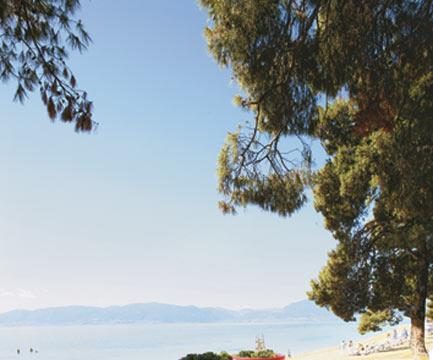Originators of the all-inclusive holiday, the Club Med group of resorts (‘villages’) has been undergoing a refurbishment and repositioning for the past four years. Its internal rating system of Tridents has been expanded and redefined, lower-rated resorts have been closed down to make way for a new crop of upgraded properties. The latest to get a makeover: Club Med’s top watersports resort, Gregolimano, in Greece.
The early egalitarian-revolutionary spirit of Club Méditerranée, a commune-style living in beach shacks in the 1950s by water polo champion Gerard Blitz, has several times done a volte-face. From a luxury traveller’s idea of ‘roughing it out’ – complete with grass-skirted hula dancers, to the 1980s appeal for swinging singles and mass-market all-inclusive family holidays, it is now on its way to the opposite of its original idea — a refined, global ethos with an emphasis on upmarket exclusivity.
Gone are the single-Trident properties; only one 2-Trident (Athenia) has survived. More 2- and 3-Trident villages have been overhauled to 4, the existing 4s have been contemporanised or upgraded, and there’s a new 5-Trident category. In a sense, it’s really a return to ‘luxury’ for Club Med (since its original customer belonged to the moneyed few), but not quite with the posh feel of a Four Seasons — this is ‘friendly luxury’, trying to hold on to the all-inclusive, convivial mores that Club Med villages and ‘GOs’ have propagated. Will it succeed? Does the ‘best of both worlds’ approach betray caution in the face of recent setbacks (from 9/11 to natural disasters)? Is Club Med still searching for its niche?
The company remains positive about its USP, the Club Med GOs — gentile organiseteurs, as the multicultural staff are known — being a model impossible to replicate. Sometimes speaking as many as 15 languages, the mix based on the resort’s profile, this young and effervescent army personifies the convivial spirit of Club Med — always highly visible, chatty, taking care of your kids, leading on the nightclub dance floor, sharing your table at mealtimes.
The ‘generous offerings’ — including meals and activities in the tariff — has gotten more generous, with the inclusion of unlimited beverages (except for premium spirits), a late breakfast and late lunch, teatime refreshments on top of the three huge buffet meals. In addition, the one-size-fits-all approach has made way for ‘à la carte’ offerings geared to the luxury segment: there are now three categories of rooms, with the highest (suites) featuring premium facilities such as room service. For the first time, Club Med’s highest rating has gone into a new luxury category of 5 Trident villages — witness La Plantation d’Albion, Mauritius and the Marrakech le Riad resort-within-resort, part of La Palmeraie, Morocco. The new focus on something for everyone has meant more choice for families. The number of adults-only resorts is down to just four. There’s now a five-way bouquet for travellers to choose from (‘exceptional’, ‘cultural’, ‘sporty’, ‘renewing’ and ‘everything’), great value and incentive to existing customers; but for bringing in new business, it may be spreading the net too thin.
The move to upmarket has found favour with travellers from Belgium and the Netherlands as well as its traditional stronghold, France; but the once key US market is yet to recover completely. A stronger net presence has helped — 30% of winter 2008 sales came from direct on-line bookings. But the India website has been less successful, perhaps because there is no local office to follow up with. The current reliance on travel agents who don’t necessarily understand the Club Med ethos sufficiently themselves, also has to change.
Visually, one wonders if Club Med wouldn’t do better to maintain at least a similarity of aesthetic — either all modern international or all culturally rooted — rather than such wild variation between ethnic-flavoured and global chic.
The Gregolimano sports resort, boasting the world’s largest water-skiing academy, has been given a fresh aesthetic by Jean-Philippe Nuel (who is also working on a Pondicherry property for Taj). It takes inspiration from the Mediterranean’s blue skies and seas, complemented by bleached wood and sheer drapes to filter and offset the brilliant light, traditional stone-flag floors, rounded pebbles echoing the colours of the beachfront, and splashes of colour to echo the green mountain and pine grove backdrop of the original 1970s hotel building. The public spaces are mostly white-and-wood textures, with the occasional highlight of bright red. The latter’s rather blocky profile has been relaxed with foliage-bordered terraces cascading down in a series of sundecks opening off hotel rooms and a spectacular set of views from the Panorama restaurant — breakfast terrace by day, Greek fine dining by night — and the reception area.
In the very first 10 days of its reopening, it had an Indian family — the Sharmas — staying with them, and are proud to relate they were well satisfied, notwithstanding the resort’s largely non English-speaking GOs. Club Med’s huge buffets, unlimited beverages, select activities and excursions should certainly appeal to the Indian VFM consciousness. However, the lack of room service (except at 5-Trident resorts and in suites) may prove a deterrent.
Then again, the well travelled already know what Club Med is and are eager for yet another European summer. However, with the South-east Asian destinations becoming the vacation of choice for the middle-class-on-the-move, the 10 Asian resorts — including Maldives, Bali, Cherating and Bintan — could do with more local promotion. Also, for the cruise-happy Indian travel market, by next season, Club Med 2 — the company’s five-mast yacht, set for an overhaul to 5-Trident — may prove a gentle introduction to luxury cruises.
Tariff for a seven-night all-inclusive holiday at Gregolimano starts at €690 for a couple. See www.clubmed.co.in




